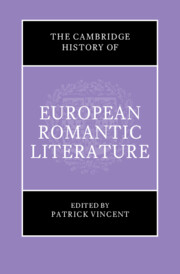Book contents
- The Cambridge History of European Romantic Literature
- The Cambridge History of European Romantic Literature
- Copyright page
- Contents
- Contributors
- Acknowledgements
- Note on the Text
- Chronology
- Introduction
- Part I Romantic Genealogies (1750–1790)
- Part II Revolution to Restoration (1790–1815)
- Part III Restoration to Revolution (1815–1850)
- 14 The ‘Restoration’ of the Restoration
- 15 Late Romanticism and Print Culture
- 16 Global Romanticisms
- 17 No Longer at Ease
- 18 Literatures of the North
- 19 Russian Empire and the Territories of Romanticism
- Further Reading
- Index
14 - The ‘Restoration’ of the Restoration
from Part III - Restoration to Revolution (1815–1850)
Published online by Cambridge University Press: 10 January 2024
- The Cambridge History of European Romantic Literature
- The Cambridge History of European Romantic Literature
- Copyright page
- Contents
- Contributors
- Acknowledgements
- Note on the Text
- Chronology
- Introduction
- Part I Romantic Genealogies (1750–1790)
- Part II Revolution to Restoration (1790–1815)
- Part III Restoration to Revolution (1815–1850)
- 14 The ‘Restoration’ of the Restoration
- 15 Late Romanticism and Print Culture
- 16 Global Romanticisms
- 17 No Longer at Ease
- 18 Literatures of the North
- 19 Russian Empire and the Territories of Romanticism
- Further Reading
- Index
Summary
Chapter Fourteen explores the relation between poetics and Restoration politics in Germany, France, and Italy. It argues that, similar to earlier aesthetic responses to the failure of the French Revolution, writers sought alternatives to the political and geographic order established at Vienna, imagining works that synthesise the past and the present in order to inspire change. After explaining why the Restoration left Britain largely unscathed, the author looks at examples of literary and political restoration in Novalis, Chateaubriand, Lamenais, and Metternich to show how restoration did not mean a nostalgic return into the past but rather the creation of something new. The chapter then compares the Restoration poetics of Quinet, Hugo and Gautier, suggesting that they advocate the ‘grotesque’ through the recovery of Shakespeare, to imagine a more comprehensive and liberal vision of society than that set forth by Metternich. Balzac’s La comédie humaine serves as a counter-example, ending in a cynicism at odds with the idealism of George Sand. The chapter’s last section compares the political uses of loss, exile, and restoration in two great Italian poets, Foscolo and Leopardi, concluding with a close reading ‘La Sera del dì di festa’ to show how political hope was kept alive.
- Type
- Chapter
- Information
- The Cambridge History of European Romantic Literature , pp. 435 - 457Publisher: Cambridge University PressPrint publication year: 2023



